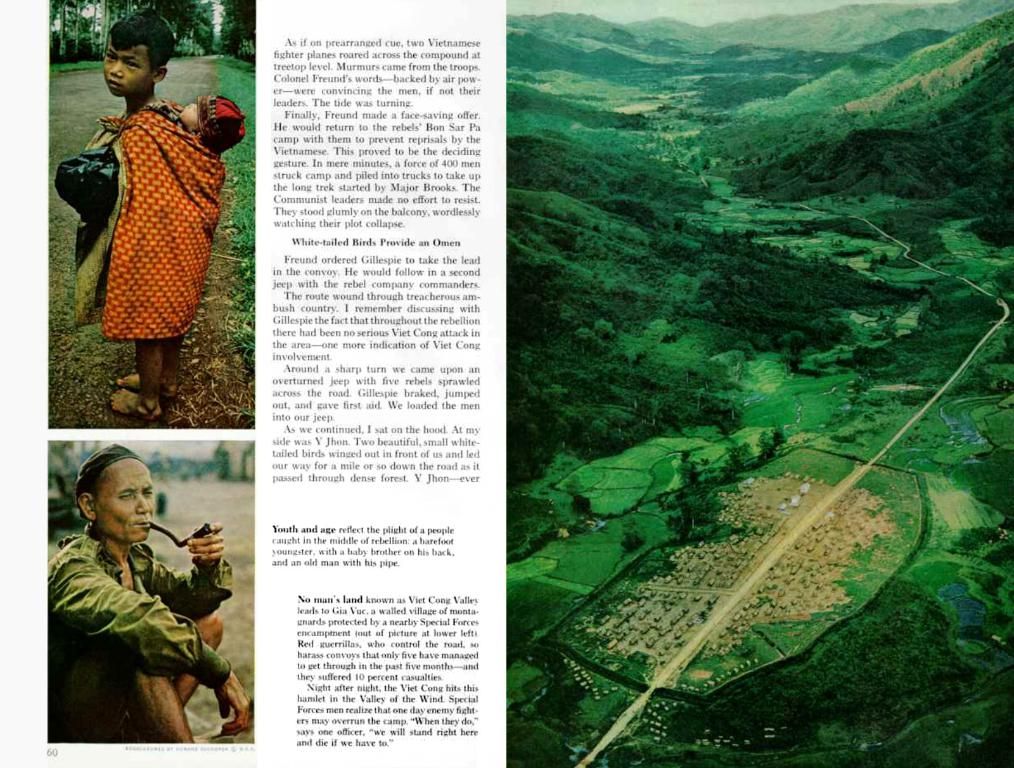As human presence grows closer to polar wildlife habitats, conflicts arise with potentially harmful consequences for both wildlife and communities.
Struggling Coexistence: Conflicts Between Humans and Wildlife in Polar Regions
Human-wildlife conflicts come into play when wildlife presence poses real or perceived costs to human interests or needs, such as loss of livestock, crop raiding, or attacks on humans. These conflicts can have negative impacts on wildlife, communities, commodity production, and sustainable development. As global warming affects polar regions, it's essential to consider the increasing complexity of human-wildlife interactions in these unique ecosystems, especially in the Arctic and Antarctic.
The Increasing Threat in the Polar Regions
The polar regions are characterized by low temperatures, extreme seasonality, and the seasonal advance and retreat of sea ice. The Arctic and Antarctic possess numerous endemic species, but their survival is at risk due to climate change, fishing, tourism, invasive species, pollution, and other factors. Pressures like these drive more frequent encounters between people and wildlife, especially in the Arctic, where around 4 million people reside.
A recent study on protecting Antarctic biodiversity found that current conservation efforts are insufficient. If global greenhouse gas emissions continue on their >2°C trajectory, up to 65% of land animals and land-associated seabirds are predicted to decline by 2100. To boost conservation efforts, strategies such as improving polluted or negatively impacted land quality, managing infrastructure, protecting areas, controlling non-native species and diseases can be employed.
Human-Wildlife Encounters in the Polar Regions
Encountering Polar Bears in the Arctic
Polar bears, an iconic Arctic species, rely on sea ice for hunting, breeding, and resting. As climate change accelerates and sea ice diminishes, polar bears are forced to spend more time on land. Finding food sources becomes challenging, and they often seek out human settlements for a predictable source of nutrition. The town of Churchill, Manitoba, is well-known as the 'polar bear capital of the world' due to the Western Hudson Bay population that passes through each summer and autumn.
Between the 1940s and 1980s, these bears regularly visited a waste disposal site, leading to property damage, human injuries, and malnutrition for the bears. Food waste was often insufficient in fat and contaminated with plastics, metals, and wood. To manage the problem, measures such as better waste management, bear relocation, temporary holding facilities, and lethal removal have been taken. The Government of Manitoba has since closed the dump site and established the Polar Bear Alert Program to minimize the need for lethal measures and reduce conflicts with bears. As encounters between humans and polar bears become more frequent, the significance of this program will likely grow.
Predators and Communities: The Effects of Hunting
Sometimes, predators feed on animals of economic and ecological significance to people. These are depredation events (events that cause damage or destruction). Mammals in the Arctic Ocean are increasingly observed preying on fish caught by commercial and recreational fishing boats. Longline fishing is the most severely affected, primarily by marine mammals like orcas and sperm whales. These depredation events can result in financial losses for fishers due to reduced catch and the need for repairs. Non-lethal responses, like using plastic fish attractors to divert predators from fishing gear, are being researched to address this issue.
Arctic Foxes and Reindeer in the Yamal Peninsula
In the Yamal Peninsula, traditional reindeer herding practices are vital to indigenous Nenet people in Arctic Russia. However, reindeer mortality has increased due to factors such as disease outbreaks, weather anomalies, and predation by Arctic foxes. The population growth of arctic foxes has been fueled by the collapse of the fur trade in the 1990s, which reduced hunting pressure. Additionally, industrial expansion provided waste for foxes to feed on, further supporting their population increase. Climate change exacerbates the issue by causing abnormal weather conditions, such as freezing rain and rapid temperature fluctuations. These events can lead to pasture icing, where a thick layer of ice forms over grazing land, making it inaccessible to livestock and wildlife.
Looking for ways to strike a balance between conservation and community needs? Check out our article on Mitigating Conflict: Balancing Conservation and Community in Polar Wildlife Encounters for more insights on managing and resolving human-wildlife conflict in the polar regions using technology, policy, community engagement, habitat protection, and education.
- Climate change not only impacts polar wildlife but also influences human-wildlife interactions, particularly in the Arctic and Antarctic, as diminishing sea ice forces species like polar bears to inhabit areas closer to human settlements, potentially leading to conflicts.
- A study on Antarctic biodiversity protection revealed that current conservation efforts are insufficient, with up to 65% of land animals and land-associated seabirds predicted to decline by 2100 if global greenhouse gas emissions continue on their >2°C trajectory.
- As climate change accelerates, the Arctic also experiences increased interactions between humans and wildlife, including fishing, which can lead to depredation events, financial losses for fishers, and the need for non-lethal responses like using plastic fish attractors to divert predators.
- In the Yamal Peninsula, Arctic fox population growth due to the collapse of the fur trade and industrial waste provision has increased reindeer mortality amongst indigenous Nenets, further complicated by climate change-induced abnormal weather conditions such as pasture icing.
- To combat these challenges, strategies for boosting conservation efforts include improving polluted or negatively impacted land quality, managing infrastructure, protecting areas, controlling non-native species and diseases, and the implementation of programs like the Polar Bear Alert Program in Churchill, Manitoba.
- Understanding and addressing human-wildlife conflicts in the polar regions is vital for both wildlife preservation and the health and wellness of local communities, requiring collaboration in environmental science, climate-change studies, fitness-and-exercise practices, and education to achieve a sustainable balance.








